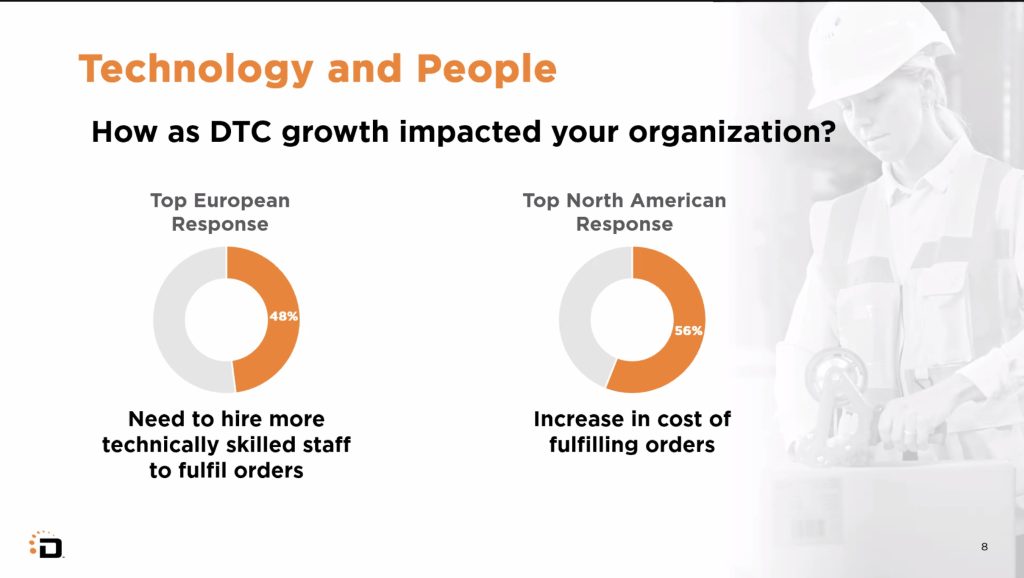In recent news, you may have seen some bold statements that direct-to-consumer isn’t the future of retail; “brick and mortar is”. And “the era of DTC brands is over”, Fast Company said. We’re throwing a yellow flag out on that one. But we’ll get to that in a minute.
First, let’s back up and define what is Direct-to-Consumer fulfillment (aka direct fulfillment, consumer-direct fulfillment, DTC, or D2C) and why it matters.
What is Direct-to-Consumer (DTC) order fulfillment?
Direct-to-Consumer is a rapidly growing sales model where brands sell directly to customers. A DTC model skips the middlemen and can eliminate some of the costs incurred by selling through big retail brands and brick-and-mortar stores.
Innovative companies are leveraging direct fulfillment to build close relationships with their customers, better personalize their offerings, and connect via important consumer values like sustainable logistics practices.
DTC Growth and Market Opportunity
Evidence shows explosive DTC growth in both Europe and North America as ecommerce accelerates the appetite to buy directly from the source of their choice rather than through intermediaries. DTC has the potential to keep growing in the near term and future term, as companies seek to differentiate and integrate more products into their existing distribution models.
For more than 58% of brands, retailers, ecommerce, and 3PL companies, DTC will make up over half of overall sales within the next 3 years. That’s according to a new survey of 300+ senior-level supply chain decision-makers. In response, businesses across the globe are augmenting their B2B and traditional distribution models with DTC order fulfillment software to garner deeper customer engagement, operational efficiencies, sales, and profit growth.
Get the full reports:
The North American Direct-to-Consumer Market
The European Direct-to-Consumer Market
Growing pains to anticipate with DTC
 Launching a direct fulfillment model also presents a range of technical and financial challenges. One of the most significant is that maintaining margins can be increasingly difficult if your fulfillment system is not fundamentally ready for the change.
Launching a direct fulfillment model also presents a range of technical and financial challenges. One of the most significant is that maintaining margins can be increasingly difficult if your fulfillment system is not fundamentally ready for the change.
As businesses introduce Direct-to-Consumer fulfillment into their highly efficient, honed-for-retail supply chains, the growing pains could hit them like a ton of bricks including high costs and the need to hire more technically skilled staff to fulfill orders.
For example, a business that uses its ERP or legacy WMS will be limited in the volume of orders it can accept because of extremely time-consuming manual workflows. That problem is compounded when the business needs to bring on more SKUs, locations, or channels. Lack of automated workflows and technology that takes weeks to learn, instead of minutes, puts unnecessary strain on the already lean workforce.
In addition, Direct-to-Consumer fulfillment will at some point require the addition of new system functionality. Legacy suites will likely cause integration challenges because they were not built to onboard or support modern supply chain applications, like marketplaces, without a long and painful custom project.
Related: Explore more about order management in DTC: Trends and Sales Impact by Industry: 2023-2026
Direct order fulfillment solutions
Modern DTC fulfillment solutions, on the other hand, were architected to scale from Day One, with pre-built WMS integrations to ERPs, marketplaces, carriers, retailer/EDI networks, material handling equipment (MHE), and more.
Direct-to-Consumer order fulfillment solutions solve the growing pains caused by inflation, reduced consumer spending, sky-high logistics costs, and fluctuating shopping preferences.
All of this underscores the critical need for businesses, especially 3PLs and ecommerce companies, to manage DTC fulfillment on a different level… The technology must provide ultimate transparency, precision, flexibility, scale, and control no matter where or how products are being sold.
Watch how Utah-based 3PL Drive Fulfillment improved customer service with Deposco, including 100% visibility within a client portal and a reduction in new-client onboarding from weeks to days:
Drive Fulfillment and other high-growth 3PL companies use Direct-to-Consumer fulfillment solutions to bring undeniable benefits including:
- Massive operational efficiencies in a very rapid timeframe
- Amplified reach and connections with customers
- Rich new offerings like personalization and sustainable delivery/sourcing practices
- Superior control over the customer experience
- Smooth technology upgrades and integrations with existing infrastructures that take very little time or cost to implement
3PL and DTC
With DTC sales surging, there is a huge opportunity for 3PL logistics leaders to take the burden off of customers and become a DTC growth leader. Top DTC brands want a a top 3PL and that means offering 3PL services that help your clients meet their growth goals.
3PL and DTC go hand in hand, but what fulfillment capabilities do you need to capture this market without passing along costs to your customer?
READ: DTC for 3PL logistics leaders
Ecommerce and DTC
DTC’s impact on ecommerce logistics has been massive. The ecommerce explosion granted consumers sudden access to enhanced buying information; consumers adjusted to that. Similarly, ecommerce supply chains must adjust to how this change has suddenly impacted their operations.
You must innovate, but do it fast. High-growth brands have found modern ecommerce order fulfillment software to be crucial in unlocking fast value and differentiation in this new space.
LEARN MORE: DTC Mastery for Ecommerce logistics leaders
Breaking into DTC
DTC sales are projected to reach $212.9 billion this year, according to eMarketer’s forecast, up from $182.6 billion last year. More than 67% of the brands, retailers, and 3PL companies we surveyed are increasing their investments in DTC fulfillment over the past 3 years, with 14% making “significant increases”.
Namely, high-growth brands are locking in technologies that extend their reach and create customer “stickiness” through flexible and speedy fulfillment options, order accuracy, personalization, and other offerings that connect with today’s shifting consumer beliefs.
LEARN MORE: How are businesses like yours breaking into DTC and making a success of it?
Inventory management in DTC
Direct-to-Consumer brings inventory management complexities that are new and unfamiliar. These challenges create a bumpier road when you consider supply challenges and overstock situations that are often out of your control.
The fickle nature of consumers has changed the rules, the competition, and the considerations for supply chains. What does it take to step up your game plan?
READ: Strategies for inventory management in DTC
Order Management in DTC
Order management systems bring all of your inventory operations into a single platform, enabling your teams to sync inventory across all touchpoints and deliver products on time with no mistakes. With super simple, flexible dashboards and reports, OMS solutions automatically select the optimal fulfillment option for your teams.
They also enhance the customer experience by handling payments, returns, and order substitutions, while making it easier to execute customer options such as buy online/pick up in-store (BOPIS), or ship directly from the store.
 High-growth brands like Dermalogica UK, a Unilever brand, have found order management and DOM systems to be crucial in unlocking fast value and differentiation in DTC fulfillment.
High-growth brands like Dermalogica UK, a Unilever brand, have found order management and DOM systems to be crucial in unlocking fast value and differentiation in DTC fulfillment.
Deposco’s Direct-to-Consumer fulfillment solutions enable Dermalogica to optimize its fulfillment processes to capitalize on the growing market demand for brands to sell direct while also enabling the company to deliver across other, more traditional channels.
Is your order management system ready for Direct-to-Consumer? Take the DTC excellence quiz.
Sustainable logistics in DTC
The consumer wants sustainability, plain and simple. While you may only have time to focus on getting boxes out the door right now, better planning of how those boxes get packed and delivered to the consumer should be a core focus of your DTC fulfillment operations to support rapid changes coming in the next few years.
Despite the consumer’s thirst for unprecedented delivery speeds, your job is to elevate your firm’s ability to connect with the planet-aware customer, including provisions for localized sourcing, timed deliveries, order pooling, zero-emissions options, and best-fit packaging strategies that present savings for both the consumer and the business.
LEARN MORE about sustainable logistics in DTC
